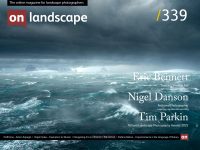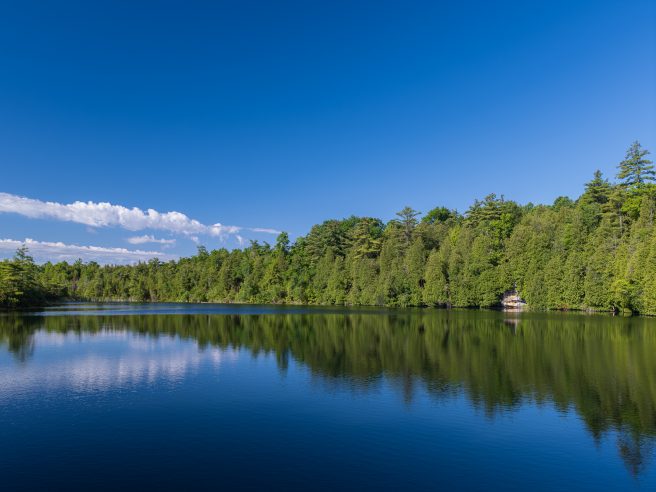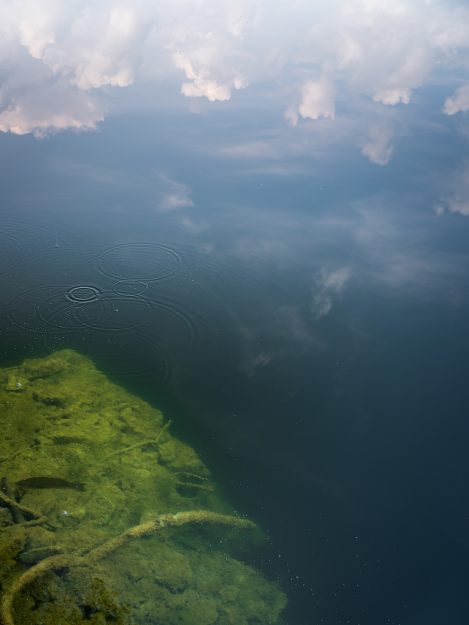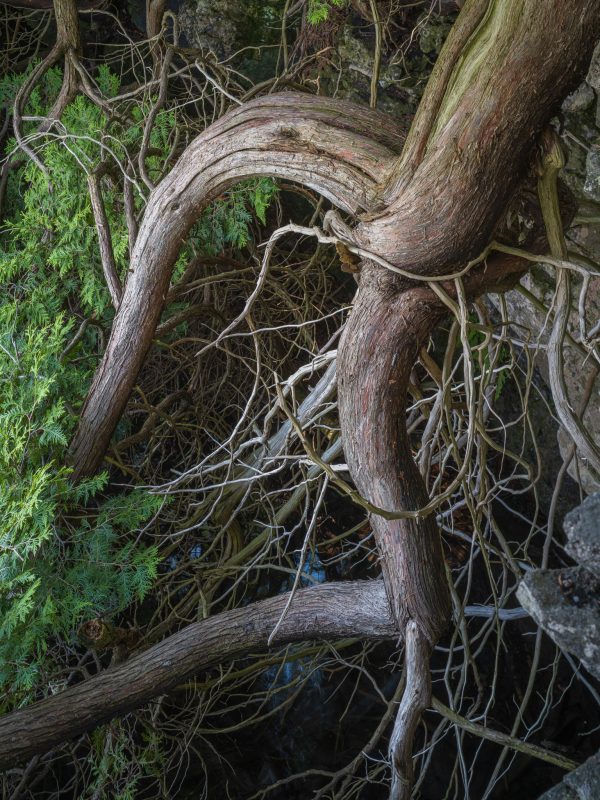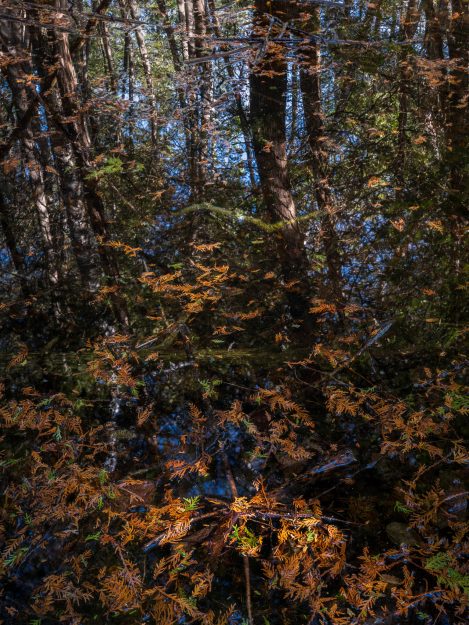Crawford Lake

Rob de Loë
I’m a professor in the Faculty of Environment, University of Waterloo. In my professional work, I'm exploring how art and science can interact fruitfully.
Since the invention of photography, scientists have used documentary photographs to explain their methods, to show results, and as sources of data. More recently, some scientists are focusing on links between science and art. For example, natural scientists in the “SciArt” community (e.g.www.sciartinitiative.org) are creating art using photographs of scientific processes and phenomena, with the goal of making science more interesting for the wider public.
As a science-adjacent water expert, I’ve seen firsthand how challenging it is for environmental professionals to connect with non-specialists whose support is important to the success of their work. Water is a very technical domain, and many people lack the basic science foundation needed to understand the issues. I’ve become interested in ways artistic photography can prompt deeper conversations about underlying scientific and technical challenges relating to water and the environment.
In art making, we are most free when we are unconstrained by the tastes and preferences of others, such as gallerists, critics, and potential buyers. In contrast, when art making is our livelihood, or when responding to external drivers is necessary, the tastes and preferences of others can matter immensely.
The challenge is multiplied when art-making takes place in a collaborative setting involving non-artists. It’s one thing for the artist to consider what hypothetical audiences might prefer. It’s another thing entirely to accommodate the preferences of actual collaborators who have their own ideas and agendas.
In the context of art-science projects, trustworthiness is an additional consideration that must be balanced. Science is rooted in reality and depends on trust. Thus, photography that is anchored strongly in reality is a natural fit with efforts to bridge art and science. It helps when the answer to the question, “Is what I’m seeing in this photograph real?” is “Yes”. But photographs that are too literal, too straightforward, may fail as art.
These considerations have been front-and-centre for me during the past three years as I collaborated with water professionals through an art-science integration project funded by Canada’s Social Sciences and Humanities Research Council. The goal of our project was to explore how artscience approaches based on photography could catalyze engagement with local water management activities in southern Ontario, Canada.
In this editorial, I use the example of my collaboration with colleagues at Conservation Halton (CH), one of Ontario’s 36 conservation authorities. Conservation authorities are science-based watershed management organizations with responsibilities for water management, environmental conservation, recreation, and public engagement.
We chose Crawford Lake, one of CH’s properties, as the focal point for a visual story that could set the stage for conversations with community members and key stakeholders about underlying scientific and technical challenges faced by conservation authorities.
Crawford Lake is a tiny meromictic lake nestled in the limestone of the Niagara Escarpment in southern Ontario. Meromictic lakes are unusual because they have two layers of water that do not mix. Conservation Halton has been stewarding Crawford Lake and the surrounding property since 1969. The property is a centrepiece in its environmental education programming, in large part because of the strong connection to Indigenous people who occupied the site historically, and who continue to live in the region and steward its lands and waters.
We envisioned several outputs for the body of work I created during 2024-25, starting with an exhibition at CH’s 50th anniversary Gala on June 12, 2025. From the beginning, we planned to use prints, rather than just a website, because we wanted to support in-person conversations among technical experts, community members, and key stakeholders.
Curating the nearly 250 candidate images I created in 2024-25 to produce a coherent visual story for the exhibition, and then writing the supporting text, was challenging but extremely rewarding. While the photographs are my work, the story we created together is ours.
The process of creating the exhibition highlighted the tensions and compromises underlying art-science collaboration. My strong preference for photography grounded in reality was a good fit for this project, but my fondness for near-abstraction and my penchant for noticing and photographing unusual things that often are missed by other people created an internal conflict we needed to solve together.
In the rest of this editorial, I briefly explore what worked for this project and what didn’t work, using a few examples. I also present a selection of images that were not used in the exhibition, primarily because they did not meet the needs of this art-science integration project; these are among my favourites from the larger body of work.
What Worked for the Exhibition
The exhibition space at the Gala had room for 20-30 photographs, divided among the core themes in the storyline we developed. I chose 57 photographs from the pool of 250 and brought prints to a workshop for 15 CH staff.
Preferences were not monolithic, but it quickly became clear that photographs that were favoured by the environmental professionals at the workshop were intelligible, fit clearly within the themes of the story, and tended to be conventional and literal.
The photograph we chose as the opener for the visual story is a good example. It is easily recognizable as a lake in this part of the world. As a photograph, it fits comfortably within the “lake-trees-clouds-reflections” style that is common in landscape photography. Indeed, CH uses an image that looks like this on a sign that welcomes visitors to the property. Photographs like this are very accessible for a general audience.
One of my favourite near-abstraction photographs from the project made it into the exhibition, but somewhat grudgingly. At our curation workshop, this image of the lake in the early morning after a rain shower was one of two candidates for the “closer” in the visual story.
Most people preferred the other candidate, a more conventional reflection image that was easier to understand. In the end, participants came around to this image because it supported a key closing message from this part of the story more effectively; it helped that the colour palette (blue and green) complemented the Gala colour palette.
The images we used in the exhibition are the best indicator of what worked for this art-science collaboration. The photographs and text from our visual story, Crawford Lake – Where Waters Gather, are available at this link: https://www.robdeloephotography.com/Works/Crawford-Lake.
What Didn’t Work for this Visual Story
Many of the 57 candidate photographs considered at the curation workshop were not favoured simply because people preferred one option over another; this is normal and expected during any curation exercise. However, from the perspective of a researcher interested in understanding how arts-cience approaches based on photography can catalyze engagement with local water management activities, I watched for other factors that shaped how participants responded to photographs.
I quickly realized that my delight in near-abstraction and unusual things in nature was a liability rather than an asset in this kind of project. Many of my personal favourites were received coolly because it wasn’t obvious enough what the viewer was seeing, or it wasn’t readily apparent how an ambiguous-seeming photograph supported a theme.
A good example is this eastern white cedar that is growing upside down from the side of a limestone cliff, into the water of Crawford Lake. I was excited to share this photograph with my CH collaborators because I considered it a good fit for the part of the story that showcased the ecosystem around Crawford Lake. However, its strangeness did not resonate with my colleagues, and they were concerned that our intended audience would not understand what they were seeing. Communication and understanding are essential to the success of the project; thus, the image did not make the cut.
With what I learned from the workshop in mind, I didn’t bother trying to convince my collaborators that we should use this next photograph of a vernal pool. These small, water-filled depressions in the limestone landscape are an important part of the ecosystem.
This photograph of a vernal pool delights me because it is literal, yet leaves much to the imagination of the viewer. However, it is not as accessible as the more conventional (yet hopefully still intriguing) vernal pool photograph I used in the exhibition (see link).
Final Thoughts,
In art-science collaborations, meeting people where they are – intellectually, culturally, and emotionally – is essential. It’s a tricky balancing act. The artist who is interested in successfully bridging art and science is not free to ignore the tastes, preferences and knowledge of the audience.
Many of my favourite photographs from the body of work I completed for this project in 2024-25 (reproduced on the following pages) were not used in the exhibition. Instead, the images we chose for our visual story tended to a more literal and conventional documentary style that prioritized understanding for a non-specialist audience.
At the same time, a major goal of the project was exploring whether visual stories like the one we created using Crawford Lake could motivate viewers to become interested in the technical and scientific topics that underpin environmental management. As an educator, I’ve learned that curiosity, wonder and mystery can get people to make the extra effort that is needed to engage more deeply with technical and scientific topics. Art can be an excellent way to access those dimensions.
Squaring this circle is a key challenge for people who are interested in using photography to deepen engagement with complex scientific and technical questions.

